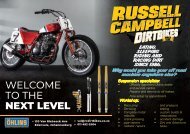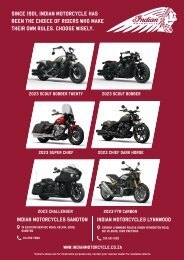RIDEFAST DECEMBER 2021
You also want an ePaper? Increase the reach of your titles
YUMPU automatically turns print PDFs into web optimized ePapers that Google loves.
So he has now built it as a display piece for<br />
a shop window, man cave, restaurant décor<br />
or the like and is open to all reasonable<br />
offers. It has been painted in period correct<br />
colours of Cardinal red and Bombay ivory,<br />
with a custom hand tooled leather seat<br />
and everything that can be polished to a<br />
lustrous shine has been.<br />
Now for a bit of a Wikipedia history lesson<br />
on the brand; a surprisingly prolific brand<br />
with a couple of championships and world<br />
records to its name and recovered from a<br />
thumping from Allied bombing in WW2.<br />
Victoria was a bicycle manufacturer in<br />
Nürnberg, Germany that made motorcycles<br />
from about 1901 until 1966. It should not<br />
be confused with a lesser-known, unrelated<br />
Victoria Motorcycle Company in Glasgow,<br />
Scotland that made motorcycles between<br />
1902 and 1928. In its early decades Victoria<br />
in Nürnberg fitted proprietary engines<br />
purchased from various manufacturers<br />
including Fafnir, FN, Minerva and Zédel.<br />
In 1920 Victoria launched the model KR<br />
1, which has a 494 cc BMW twin-cylinder<br />
side-valve flat twin (boxer engine) mounted<br />
longitudinally in the motorcycle frame. The<br />
engine produced 6.5 bhp and transmission<br />
was via a two-speed gearbox.<br />
When BMW started making its own<br />
motorcycles, Victoria turned to making its<br />
own engines. In 1923 Victoria launched its<br />
KR 2, an overhead valve flat twin producing<br />
9 horsepower. In 1924 Victoria followed<br />
this with the KR 3, which produces 12<br />
horsepower and has a 3-speed gearbox.<br />
In 1925 Victoria built Germany’s first<br />
forced induction engine, and in 1926 a<br />
496 cc Victoria achieved a motorcycle<br />
land speed record of 165 km/h. In 1927<br />
Victoria launched the 596 cc KR VI or KR<br />
6. Based on this model the factory offered<br />
a high-speed sports model with twin<br />
carburettors that produced 24 bhp, later<br />
named the KR 7. At the same time Victoria<br />
also offered the 200 cc side-valve KR 20<br />
and 350 cc overhead valve KR 35 models.<br />
In 1930/31 it added to its range the KR 50<br />
(side-valve) and KR 50 S (overhead valve)<br />
models, which have engines imported from<br />
Sturmey-Archer in England.<br />
In 1932 Victoria won the sidecar class of<br />
the European Hill Climb Championship with<br />
a 600 cc machine and thereafter offered<br />
a model with 20 bhp and a four-speed<br />
gearbox as the KR 6 Bergmeister, Mountain<br />
Master). At the same time it offered the KR<br />
15 and KR 20 Z models with 150 cc and<br />
200 cc two-stroke engines supplied by ILO.<br />
In 1933 Victoria introduced a 500 cc parallel<br />
twin, the KR 8. This had a side-valve engine<br />
with its cylinder block inclined forwards<br />
almost horizontally. This placed the valves<br />
under the cylinder head, where the exhaust<br />
valves suffered from overheating. In 1934<br />
the National Socialist government forbade<br />
the import of foreign components,<br />
<strong>RIDEFAST</strong> MAGAZINE <strong>DECEMBER</strong> <strong>2021</strong> 47


















